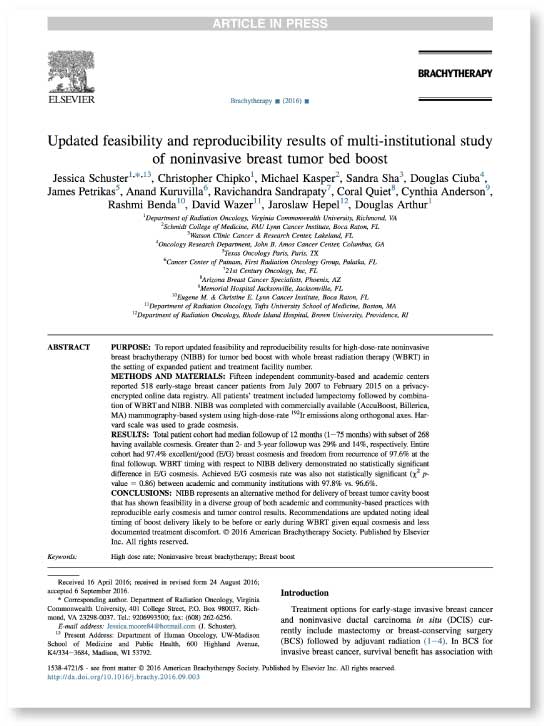Updated Feasibility and Reproducibility Results of Multi-Institutional Study of Non-Invasive Breast Tumor Bed Boost
A Dosimetric Comparison of Two Boost Techniques
Jessica Schuster 1,*,13, Christopher Chipko1, Michael Kasper2, Sandra Sha3, Douglas Ciuba4, James Petrikas5, Anand Kuruvilla6, Ravichandra Sandrapaty7, Coral Quiet8, Cynthia Anderson9, Rashmi Benda10, David Wazer11, Jaroslaw Hepel12, Douglas Arthur1
1Department of Radiation Oncology, Virginia Commonwealth University, Richmond, VA 2Schmidt College of Medicine, FAU Lynn Cancer Institute, Boca Raton, FL 3Watson Clinic Cancer & Research Center, Lakeland, FL 4Oncology Research Department, John B. Amos Cancer Center, Columbus, GA 5Texas Oncology Paris, Paris, TX 6Cancer Center of Putnam, First Radiation Oncology Group, Palatka, FL 721st Century Oncology, Inc, FL 8Arizona Breast Cancer Specialists, Phoenix, AZ 9Memorial Hospital Jacksonville, Jacksonville, FL 10Eugene M. & Christine E. Lynn Cancer Institute, Boca Raton, FL 11Department of Radiation Oncology, Tufts University School of Medicine, Boston, MA 12Department of Radiation Oncology, Rhode Island Hospital, Brown University, Providence, RI
PURPOSE:
To report updated feasibility and reproducibility results for high-dose-rate noninvasive breast brachytherapy (NIBB) for tumor bed boost with whole breast radiation therapy (WBRT) in the setting of expanded patient and treatment facility number.
METHODS AND MATERIALS:
Fifteen independent community-based and academic centers reported 518 early-stage breast cancer patients from July 2007 to February 2015 on a privacy- encrypted online data registry. All patients’ treatment included lumpectomy followed by a combination of WBRT and NIBB. NIBB was completed with commercially available (AccuBoost, Billerica, MA) mammography-based system using high-dose-rate 192Ir emissions along orthogonal axes. Harvard scale was used to grade cosmesis.

RESULTS:
The total patient cohort had a median follow-up of 12 months (1e75 months) with a subset of 268 having available cosmesis. Greater than 2- and 3-year follow-up was 29% and 14%, respectively. The entire cohort had 97.4% excellent/good (E/G) breast cosmesis and freedom from recurrence of 97.6% at the final follow-up. WBRT timing with respect to NIBB delivery demonstrated no statistically significant difference in E/G cosmesis. Achieved E/G cosmesis rate was also not statistically significant (c2 p- value 5 0.86) between academic and community institutions with 97.8% vs. 96.6%.
CONCLUSIONS:
NIBB represents an alternative method for delivery of breast tumor cavity boost that has shown feasibility in a diverse group of both academic and community-based practices with reproducible early cosmesis and tumor control results. Recommendations are updated noting the ideal timing of boost delivery likely to be before or early during WBRT given equal cosmesis and less documented treatment discomfort. ! 2016 American Brachytherapy Society. Published by Elsevier Inc. All rights reserved.